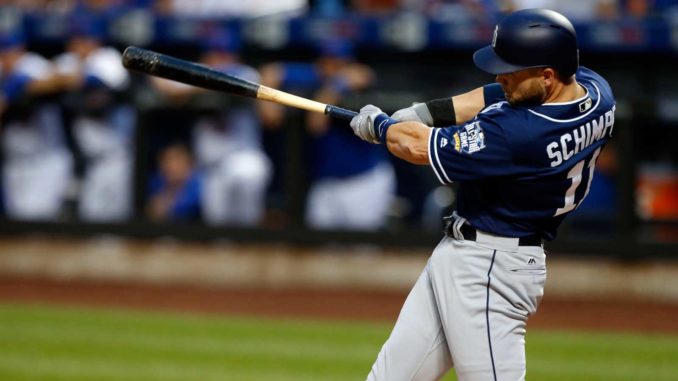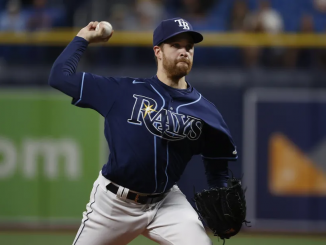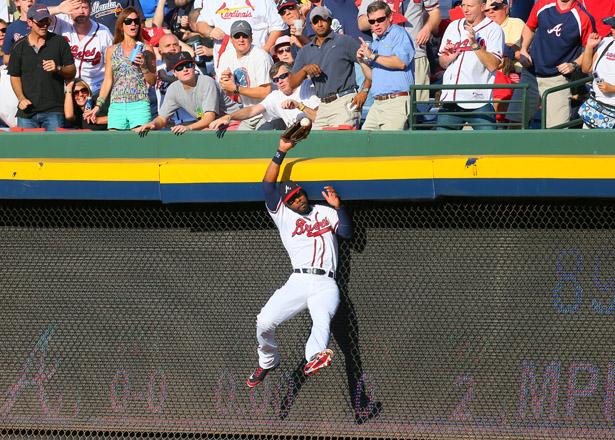
Acquired IF Ryan Schimpf from the Tampa Bay Rays for cash considerations.
Outrighted RHP Josh Ravin to AAA Gwinnett.
For the second time since the end of the 2017 season, the Braves have acquired a player forced off the Tampa Bay Rays 40-man roster. The first was right-hander Chase Whitley in December, and now Atlanta has taken advantage of Tampa needing to clear a roster spot for the recently signed Carlos Gomez, acquiring infielder Ryan Schimpf.
Fly Ball Extreme
One of the most discussed trends in baseball the last couple have seasons has been the “fly ball revolution”. Several big-name hitters, notable Toronto’s Josh Donaldson and Los Angeles’s Justin Turner, have been preaching the gospel of trying to uppercut the ball in order to get the ball into the air more. For players with power, it makes sense to get the ball in the air as much as possible, since in the majors the vast majority of ground balls go for outs, and even the ones that get through the infield are generally only singles.
The Braves’ new acquisition has been a center of fascination for baseball analysts that have been studying this trend. In Schimpf’s rookie season of 2016 with the Padres, he came in second all time for any hitter for the highest fly-ball rate (64.9%) and the biggest ratio of fly balls to ground balls. This allowed the 5′-9″ infielder to rack up 20 home runs and produce a 130 wRC+ despite only hitting .217 on the season (.336 OBP) with a 31.8% strikeout rate. He only had 60 hits on the season, which means a third of all of his hits were home runs.
Then in 2017 he somehow became even more extreme, hitting a remarkable 68.5% fly ball rate which would have broken the record if he had gotten enough plate appearances to qualify. Oh yes, about that… his strikeout rate also somehow managed to go up as well, to 35.5%. This combination caused his batting and on-base averages to drop to .158/.284, low enough that even generating 14 home runs in only 197 plate appearances couldn’t off-set in value.
The Padres pulled the plug of the Schimpf Experience in mid-June, optioning him back to AAA El Paso to play out the year. In December, the Padres traded Schimpf to Tampa Bay for fringe minor leaguer Deion Tansel.
The Schimpf Fit
So how does Schimpf fit in the Braves picture? Schimpf is a second or third baseman by nature, so he provides more depth at those positions. He doesn’t seem to be a threat to the incumbencies of either Ozzie Albies or Johan Camargo at second and third respectively. It seems that Schimpf most clearly represents a challenge to the roster chances of Rio Ruiz, who is a left-handed hitting third baseman like Schimpf. Also like Ruiz, Schimpf projects as a major-league average defensive third baseman.
If somehow Schimpf can control his swing-and-miss tendencies and provide more on-base ability to go along with his home run power he could represent a legitimate platoon option at third base. Historically, Camargo has hit better from the right side of the plate, and if those trends continue either Schimpf or Ruiz could potentially grab a chunk of plate appearances against right-handed pitchers.
Ravin Now a Striper
The other half of this transaction is that RHP Josh Ravin managed to clear waivers and was outrighted to the AAA Gwinnett Stripers. This cleared a spot on the 40-man roster for Schimpf.
Ravin was considered a likely Opening Day reliever before spring training, given his impressive fastball/slider combo and the fact that he was out of options. His Grapefruit League performance however has not impressed.
Ravin will go to the minor league camp to work try to work on his control and hopeful force his way back to consideration for the Braves.




Leave a Reply